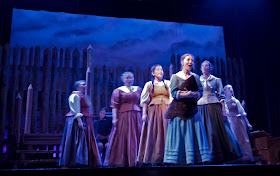 |
| Julie McIsaac - York Theatre, Vancouver, May 17 2018 |
As a Buenos Aires-born Latin American I have gone far and long in my quest to understand that North American experiment that is the musical. Perhaps I must thank my exposure to all those musicals I have seen at the Arts Club Theatre to finally realize that musicals don’t always just entertain.
That was the case in last year’s Corey Payette musical The
Children of God and this year in the same location, at the Cultch’s York Theatre for Les Filles Du Roi.
Dazzling Movement at the Children of God
You have guilt, I have sorrow
Dazzling Movement at the Children of God
You have guilt, I have sorrow
After the play (opening last night Thursday May 17, 2018)
when Rosemary and I returned I did not immediately go to sleep. I thought of
1962 when my mother raved about Lawrence Durrell’s Alexandria Quartet (
Justine, Balthazar, Mountolive & Clea). These four separate novels are about
the same events but seen by three different points of view in the first three
novels). My mother had taught me something that would serve me well in my years to come
In this 21st century where facts and truths are
hazy I have come to the conclusion that “point of view” is of supreme
importance. By weighing these looks from different directions and by different
persons the collective approaches some sort of truth.
Corey Payette and Julie McIsaac’s (Book and Lyrics) musical Le
Filles Du Roi looks at the events in the 17th century in the French
settlements in Canada when the Sun King decided that vast land had to be
populated. He sent women in ships for that task.
Les Filles Du Roi has two principal points of view (and a
few more small ones). One view is from the white man who is out to “save” the
savages. The other view is of the Mohawks (Kanien'kehá:ka) who do not understand that concept and are
just fine the way they are. After all the sparse country that is their land is populated
enough.
There is a third point of view that for me is also
important. The famous photograph of Nazi “publicist” Joseph Goebbels taken byAlfred Eisenstaedt in 1933 is famous because we look at it from a future in
which the horrors that occurred we see in retrospect in Goebbels formidable
gaze.
For me having been raised a Roman Catholic and sent to a
Catholic boarding school in Austin, Texas and lovingly adoring (in spite of my
lapsness) our Argentine Jesuit pope, I was pleased to observe that Andrew Cohen
(who played the villainous Clarke) in his stand-in role as the Jesuit (Clark
told me that being a Cohen he was not a Jesuit but a Jewisit!) played him innocuously
good.
This musical is in the standard (and most necessary)
three-act structure of 1. Introduction of characters, 2. Introduction of
conflict 3. Resolution. It entertains but it challenges.
Because Payette gently eased me out to the door on Wednesday’s
media call I was not able (thank you Mr. Payette!) to discern the startling
resolution in which one of the damning villains Madame Savoie (a sort of bitchy
nun, that wasn’t a nun who reminded me of Lana Turner’s nasty Milady in The
Three Musketeers) played by Laura Di Cicco has a change of heart.
It was only after re-reading my program notes that I found
out that the co-book and co-lyric Julie McIsaac also plays the lead Mari-Jeanne
Lespérance, a Filles du Roi whose only sin was to refuse to drink tainted water
on the sea voyage from La Rochelle. She and Kaitlyn Yott as the Mohawk sister
Kateri (the use of squaw here would damn me) of Jean-Baptiste played by Raes Calvert, are very
good singers who happen to know how to act.
I have no idea if two musicals from Payette can form a
visual pattern for me. As a photographer who has refused to ever shoot videos I
was transfixed by my amateurish swirls of the dance scenes at ¼ second. In them
I noticed a wonderful pattern of excellence in Production Design, set costumes,
props by Marshall McMahen and lighting design, Jeff Harrison in which I could
see this play hearing impaired and still being able to enjoy all the visuals.
But I must return to my point of view, point of view. In
1985 (I arrived in Vancouver in 1975) one of the first Canadian books I ever
read was Black Robe by Brian Moore. This novel is about the events in the time
of Les Filles du Roi as seen by a Jesuit priest. I wrote about it here.
And lastly I could not leave out the music. It is catchy, it is lovely and the four musicians, Rachel Kiyo Iwaasa, piano, Molly McKinnon, violin, Rebecca Wenham, cello (I have photographed all three at one time) and John Kastelic, viola and pump organ are very good. Some my have noticed that Wenham did tap and bang on her cello (percussively) in some of the songs. But perhaps fewer would know that Wenham who is part of Marc Destrubé's Microcosmos Quartet is expert at this after all, all the Bartok Quartets that Microcosmos has played in the last couple of years involve lots of that!








































